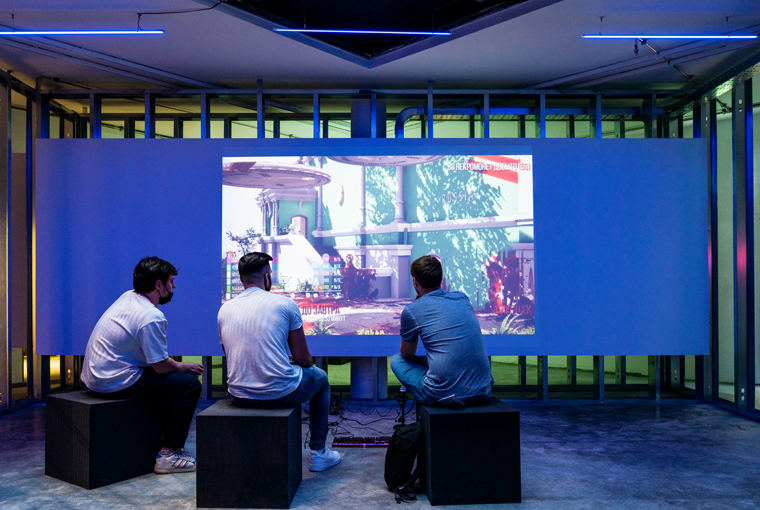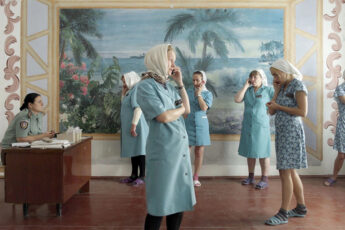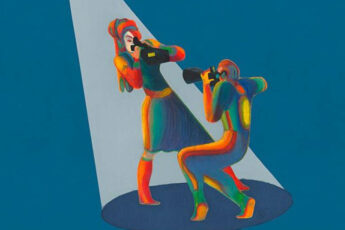
This year, the Russian Pavilion for the Venice Biennale featured a film program called Into the Sandbox. It was curated by Vladimir Nadein, co-founder of the Moscow International Experimental Film Festival. The film program is centered around virtual realities: be it video games, futuristic CGI dystopias or other digital environments.
The program is divided into three thematic sections. The first one, called “God Mode”, includes CGI animated films that share what can be called a futuristic (and partly posthuman) perspective. Both Alice Bucknell’s Swamp City and Keiken and George Jasper Stone’s Feel My Metaverse take place in a time of global ecological collapse that leads to the creation of new inhabitable infrastructures – the establishment of an eco-retreat and “life units” respectively. In his film AIDOL, Lawrence Lek looks at the destiny of creativity in a future that is only partly human. All of these films present an unnerving vision of a future society dominated by technocratic megacorporations. They suggest that maybe we shouldn’t fear the technological advances of AI so much as we should fear the irrational human mind that can find the most dangerous ways of exploiting these advances.
The second thematic group is called “AFK!”and focuses on the military background of first-person shooters, as well as addressing the ways virtual violence is related to real violence. Total Refusal’s How to Disappear tests the “harmlessness” of online shooters by looking at the figure of the deserter; Ismaël Joffroy Chandoutis dedicates a film to the swatting phenomenon; in Hotel, Benjamin Nuel rethinks not only the ways that the mechanics of classical shooters like Counter-Strike transform our conception of “the act of killing”, but also the way our gaze becomes that of the dead “spectator”, and how the surfaces of our imaginary worlds come to adopt the properties of game textures.
Finally, the “Instance Dungeons” section of the program further develops the theme of game–life interactions. In Antoine Chapon’s My Own Landscapes, we meet a veteran who is also a military game designer and discover how gaming engines help, first, to prepare soldiers for battle, and then – to recover from war-related traumas; Total Refusal’s Featherfall draws a comparison between the archetypal motif of free falling we encounter in our dreams and a recurrent glitch in games consisting in falling through textures; Dana Karaman’s Letters About the End of the World – a video-diary of self-isolation shot during the COVID pandemic, – though interesting in itself, seems orthogonal not only to this section but to the whole film program.
The overarching “sandbox” metaphor of the film program connects with the title-lending idea of this year’s Russian Pavilion, which simply reads “Open”. The Pavilion was reconstructed and redesigned for this year’s Biennale in an attempt to match its initial conception created in 1914 by Russian architect Alexey Schusev, who wanted to blur the line between the building’s exterior and interior as much as possible. Schusev created large skylights, a terrace with a view of the lagoon, an outside space, a staircase, and several openings on the surrounding greenery. The light-green color was also supposed to help blend the building with its surroundings. The fact that these ideas have been refreshed and further developed this year by Kovaleva and Sato Architects meaningfully reflects this year’s main theme, as does the way films share exhibition spaces with video games, whereby the determinacy of material that is “directed” meets the indeterminacy of material that is “played”. It is this overall disposition that best underlines the interaction between real and digital ontologies that is at the heart of the film program.
Benjamin Nuel’s Hotel (2014) is a good example of such a form interaction. In his 3D animation film, the classical FPS antagonists – Terrorists and Policemen – are stuck in the middle of the forest in a hotel maintained by a chicken. They are desperate to get back to the battle, but no orders arrive, so they kill time by playing Hold ‘Em and – from time to time – by killing each other. The Counter-Strike-1.6-like animation style and the whole set of laws that the game mechanics impose on this world create cinematic conventions that seem very refreshing and thought-provoking. The eye of the camera calls to mind the “Spectator mode” with its mechanistic movements and ability to pass through objects and people. The characters brush their teeth or spit out after flushing without taking their balaclavas off. The characters’ interaction with the landscape is game-like and becomes plot-organizing when the world starts to crumble and objects start to fall through textures.
As the film’s primary reference is the game world instead of the real world, we encounter a very distinct type of ontology that manifests itself on every level: all characters seem to have the same father, the same wife and the same memories, they have all “died” many times (obliged by the cyclical nature of multiplayer FPS modes), so death is considered an unfortunate yet not irredeemable event. Although the film regularly reminds us of the programmed nature of the characters’ “identities”, making their looks and even some of their gestures and postures identic, we simultaneously begin to witness differentiation when the characters are taken out of their natural “habitat” of the battle and put in the most humanly situation – a state of indefinite waiting. The functional roles of Terrorists and Policemen fall apart, and more subtle relations start to form – that’s why Hotel is not a classical machinima. Watching Hotel is a kind of cinematic experience that makes you question the futuristic paths where game and film development will intersect – the way the games being played will grow closer and closer to the films being directed.
The Hotel’s theme of “devaluation” of violence that is intrinsic to the gaming world since its early days is present in many other films in the program. Total Refusal’s pacifist film How to Disappear (2021) examines the relation of war games to the war phenomenon through a single figure – that of the deserter – and through a single game – “Battlefield”. If in reality desertion represents a certain war act with its history and its set of possible meanings and consequences, this is because it instantiates, in every case of its occurrence, the opposition of war to peace. In a war game, where there is no alternative to war, desertion is either absurd or impossible. The peaceful landscapes stretching to the horizon around the player are empty and forever unattainable – they are textures, a wallpaper on the cage of the battlefield. Leaving the battlefield leads to immediate death, and refusing to fight is ridiculous. Fighting is fun, there is nothing more to it. So refusing to fight is just not funny. What could become social suicide in real life, is a silly joke in the game. You can’t desert, but you also can’t be punished for desertion by your comrades in the same way you would be punished at war, because there is no friendly fire in most war games. Long story short, what is absent about war in war games is the ambiguity: there are friends and foes, and no place for any in-between figure. According to Total Refusal, war games follow a capitalist logic of aestheticizing war, not only turning it into a convenient pastime, but also building the classic war-idolatry by making the act of not fighting impossible.
If the deserter in the tradition of nation-state ideology was someone not worth living, a bearer to a kind of illness that becomes manifest in the bodies of soldiers, the deserter in a war game is also a kind of mistake, someone for whom there’s no place, someone who is not playing. Consequently, in war games we confront the outdated picture of war: only if in reality the question of its legitimacy was obliterated by patriotic ideologies, in games it is obliterated by the ideology of fun. In the film, these ideas are rendered by machinima visuals depicting different metaphoric ways of undermining the one-directional war game motivations: soldiers motionlessly “hiding” from war in bushes and behind trees, jumping from a cliff and dying, trying in vain to kill a deserter teammate, randomly shooting, disappearing in the smoke of a grenade.
Ismaël Joffroy Chandoutis’ Swatted (2018) examines swatting as a way that digital environments transcend their boundaries. Swatting stands for a cyber-harassment phenomenon that consists of tricking the police emergency services into sending a team of a SWAT type to break into a person’s house. More specifically, the film explores the use of swatting against popular streamers during their streams, making the whole break-in operation visible for the watchers in real time. By arranging these dangerous pranks, usual web trolls become “swatters” and pass from verbal bullying in stream chats to taking direct action. This may be seen as their way of counteracting the streamer’s power to kick them from the chat by “kicking” the streamer from their own stream: hence, apparently, a kind of inverted Herostratus’ pleasure they get by using the swatted person’s audience against them while remaining completely anonymous. The spark of attention that the swatting produces can have the most surprising implications. Could it be that some of the swatted themselves are ready to “play the game”? As one of the interviewees reveals in the film, there are cases of “a prank of a prank”, where streamers set up a fake swatting in order to gain more subscribers.
The visual approach that Ismaël Joffroy Chandoutis chose to depict the swatting phenomenon is rather interesting. Apart from including testimonies of some of the swatted streamers, he rendered the very reality of the streamers’ households in forms of 3D game modeling, while stressing the transparent nature of the models. Just like real armies use gaming tournaments to hire future soldiers (as Antoine Chapon points out in My Own Landscapes), the whole real-life streaming situation presents itself to the swatters very similarly to a game that has to be hacked: the way the swatter accesses the room of the streamer can be compared to the wallhack cheat-code popular in first-person shooters, only that the enemy is real and the walls start to crumble the moment the swatter gets the address right.
There are several films in the program that do not concentrate on the relation between the virtual and the real so much as they focus on the ways that the virtual that has always existed – in forms of dreams and imagination – is enriched and transformed by the development of digital environments. This is what Total Refusal aims at in Featherfall (2019) – a four-channel video installation that represents a series of recordings from different games that feature the glitch effect of falling through textures, while two voice-overs comment on different ways in which games and dreams are connected.
In the online roleplaying classic World of Warcraft, “Feather Fall” was a spell that let you jump from heights without dying by making you fall as slow as a feather. The same effect occurs when a programming error in a game makes you fall through a surface into an empty space without ever landing. Total Refusal noted a similarity between the featherfall effect and what they call “the archetypal nightmare of ‘falling down’”. The project thereby refers to the surprising ways gamers’ dream worlds are influenced by the logics and mechanics of the games they play: some gamers, for example, see their health bar in dreams, others complete missions or gather points. But maybe, what that indicates is not so much the proximity of the game and dream worlds as the fact that games permeate some gamers’ reality to such an extent that unresolved gaming situations find their way into dreams just like unsatisfied desires do. The main metaphor of the installation – that of an endless fall, or “a glitch as a digital nightmare” – seems appealing at first glance, but its relation to the broader theme of game–dream relations seems a bit forced. It is hard to say what a glitch really has in common with a nightmare that, as any other dream, represents a significant rule of human existence, not a random programming error. While the featherfall glitch destroys immersion in the game by exposing its constructedness, the free fall in a dream produces, on the contrary, an acute intensification of its experience.
Another strand of the game–dream problematics is represented by films from the “God Mode” section, each of them producing their own “dream” in the form of a vision of the future. Lawrence Lek’s AIDOL (2019) is interesting in this regard. It takes place in a futuristic universe that Lek has begun creating in his previous films Sinofuturism (1839–2046 AD) and Geomancer. AIDOL is centered around the 2065 eSports Olympic finals where a team of humans – “Bios” – faces a team of AI machines – “Synths.” The competition is sponsored by the Farsight megacorporation that supports the human team. This conflict is mirrored and outweighed by another one that seems secondary at first: Diva, a fading superstar singer, is preparing a new single for the event but has a hard time satisfying the demands of the Farsight administration, so she decides to hire Geomancer, an intelligent satellite and AI songwriter, to help her write the LP and get back on the horse. Unlike usual futuristic dystopias that play up our fear of artificial intelligence gaining control over humanity, Lek’s future is mostly human, where this humanity seems to be reduced to producing two specifically human types of pleasures: pleasures of power and pleasures of worship. It is humanity gaining control over itself that creates what one character calls the “society of the generic”. Therefore, it comes as no surprise that the authoritarian force ruling this universe is Corporation Farsight, whose motto is “Aligning AI with human interests”, and whose logo is a glowing neon eye – a kind of political force resemblant of Big Brother. The AI species last raised their heads on the Deep Blue Monday (a reference to the first computer to beat a reigning world champion in chess), the day the troubles started and they had to submit to “human interests.” What makes Lek’s universe so outstanding is the opposition between a cynical humanity that wants to win at any cost, and machines dreaming of beauty and creativity and desperately learning to lose; between the greedy, vain and irrational “human interests” that limit humanness – and the AIs with their desperate and sublime dreams of breaking the limits of their programmed selves and acquiring just a bit of the humanness of their creators.




Leave a Comment